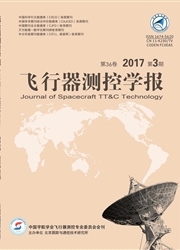

 中文摘要:
中文摘要:
基于"嫦娥二号"卫星再拓展试验的设计轨道,研究各种摄动力对轨道确定精度的影响,得出的结论是:若要达到km量级的轨道确定精度,必须考虑除天王星和海王星之外所有大行星以及日月的质点引力。文章进一步利用数值分析法研究再拓展任务的轨道确定精度,分析结果表明:基于目前的测控条件,使用30 d以上的测轨弧段可以得到稳定可靠的轨道解,而短弧(小于20 d)稳定轨道的获取需要VLBI(甚长基线干涉)测轨数据支持;当"嫦娥二号"距离地球700万km时,测控精度可优于30 km;虽然每天测轨弧段的增加可以改善轨道精度,但是当增加到8 h以上时,定轨精度将不再有明显改善。
 英文摘要:
英文摘要:
The impact of perturbations on orbit determination accuracy is studied based on the designed orbit during the second extended experiment mission of CE-2 (Chang' E-2) satellite. The conclusion is that mass points of the sun, the moon and all major planets except the Uranus and Neptune should be taken into consideration to obtain km level orbit determination accuracy. The orbit determination accuracy of the second extended experiment mission is studied further with numerical analysis method and the results show that a stable orbit solution can be got with tracking data of an arc of more than 30 days. VLBI (Very Long Baseline Interferometry) tracking data is required to get a stable orbit solution for an arch shorter than 20 days. An orbit accuracy better than 30 km can be got when CE-2 is 7 million km away from the earth. While the increase of daily tracking duration increases orbit accuracy, no significant improvement will be seen when the tracking arc is over 8 hours.
 同期刊论文项目
同期刊论文项目
 同项目期刊论文
同项目期刊论文
 期刊信息
期刊信息
